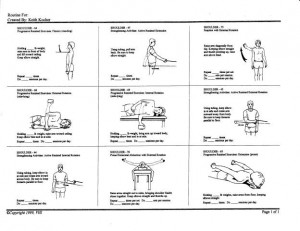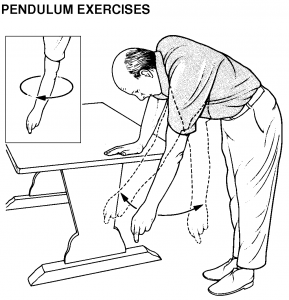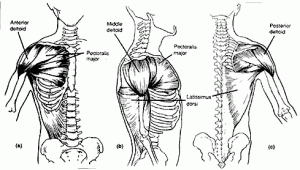Three weeks removed from my shoulder surgery, not much has changed since my last post. It’s typical during recovery from Open Bankart surgery to plateau. In other words, there are points where you seemingly do not progress and in some instances take a few steps back. This is due to the way your body naturally recovers. Left unattended there are major side effects to shoulder surgery such as muscle atrophy, which is a weakening of the muscles due to lack of use. There is also a danger of tightening of ligaments and tendons leading to paralysis of the shoulder and arm. The root culprit of this is two fold.
First, scar tissue (while stabilizing the overall structure of the wound) creates a hardened almost callas like formation within the arm preventing normal range of motion. The second, is because your arm stays in a protected position (usually close to your body and slightly bent with the shoulder propped forward) similar to when it was in the sling. Because of that positioning the arm muscles literally begins to form and stabilize in that unnatural position. This places a tremendous burden on your neck and back, as well as, leading to a limited range of motion in the shoulder itself. It also causes the now shortened ligament to begin tensing up and shortening themselves. The result is the tendons and ligaments become so tensile it becomes hard to fully open and extend your arm. This effect is particularly noticeable during the morning when you first take your arm out of the sling and alleviates over the first few hours (especially after I do my morning exercise regimen) with normal use. Left unattended for weeks though the ligaments would become near impossible to move and tighten to a dangerous level of shortening.
The scar tissue is good though. My orthopedist actually purposely created scar tissue during surgery because during the course of letting my shoulder deterioate in the years prior to surgery I actually destroyed the scar tissue that was trying to form in my shoulder. As stated earlier, the scar tissue is necessary to help stabilize/support the joint, which prevents tearing and provides a tough layer of tissue to protect the joint, but this tissue must be strategically broken apart so it does have flexilbity enough to allow normal range of motion.
We’ll get into how they address all these under use dangers later in the post when I discuss PT (physical therapy).
The exact opposite can be said about over use. Over using or extending the joint beyond the shoulder line (such as washing your hair or reaching upward) or applying weight over 5 lbs. during lifting of objects comes with the risk of tearing the scar tissue at the incision point, as well as, causing a shoulder dislocation risk that would effectively undo your surgery. This risk is particularly high during the first six weeks after surgery. Common sense and caution must be used. If something causes pain verses normal discomfort you need to stop doing whatever you’re doing immediately. If that painful feeling does not subside within a few minutes you need to call your doctor ASAP.
The final big risk is infection and normal daily showering will prevent this along with being sure to change your shirt each day. I know this sounds like common sense, but you must keep yourself clean hygiene wise to avoid infection. I also like during the last part of my shower to turn the shower head on massage and kick up the heat on the water a bit. I run my arm, back, and opposite arm under the warm jet stream slowly for a total of about 10 minutes. This warms and soothes all the muscles helping to expedite healing. After three weeks, according to my PT, you can begin moving away from ice and towards heat. Ice is for post PT work out, but heat is for sitting around the house and relieving normal aches/pains that may arise. Purchasing a heating pad is thus a great idea.
This brings up the balance that at three weeks you must walk. You should use your arm where ever possible, but you should also not over use the arm. I’ve limited my arm usage to typing, limited body washing in the shower on the torso and abdomen, occasional eating, and light sweeping. These short, brief, and non-intensive tasks test the shoulder without tasking. You should not do any motion that requires upward or outward extension such as reaching above your head. You should around the house when awake not wear the sling at this point. Keep your arm free and let it rest on a pillow verses be in the sling.
As mentioned above, ice is important as well during the first three weeks. You should ice your shoulder with an ice pack for at least 20 minutes three times a day during the third week. As noted before, you’ll then switch to a combo of ice after exercising and heat to relieve aches/pains after three weeks for five minutes after the work out. This keeps swelling down and helps relieve the soreness associated with the in home or at PT therapy regimen. Speaking of the regimen, it is important you do your daily prescribed exercises. These motions have helped soften the plateaus and long term I notice improvement to the overall range of motion in the shoulder by religiously doing them each day.
When not in use I try to prop my shoulder up. The key is to get the shoulder not to slump forward. Putting a pillow under my arm while sitting watching TV helps make this happen (as noted above).
The most important thing is to not let soreness slow you down to a halt. Yes, you can rest your arm and ice your arm. You should take your pain meds as prescribed. By all means though, unless told otherwise by your medical professionals, do not stop using your arm completely. It is important to work through discomfort and to keep going despite it. There is a noticeable difference between discomfort and pain though. My movements may come with soreness or discomfort, but anything over a three on the pain meter should be noted to your medical professional ASAP. I make sure to tell my PT and orthopedist during my visits any pain no matter minor regardless though as point of habit. It’s better to be told that’s okay then to ignore something that turns out to be important.
This evening I will be taking my last Vicodin. I’m going to try to go on Ibuprofen alone. The pain meds are there to support your capabilities and again– depending on your pain threshold you may need them longer. I’ve been these past few days extending my med time interval to 8 hours to see how manageable the pain was with just the Ibuprofen. Again, this is part of the dialogue between you and your medical professionals.
I’m able to drive one handed short distances (say less than 5 miles) on one off occasions. I do so with my meds well worn off (do not be medicated and drive– it’s as bad as drinking and driving if not worse), but at this point driving with any regular ability would be impossible. I leave the vast majority of driving to my wife.
I’ve still having some trouble sleeping full nights. I don’t wake up tired, but I find that every six or so hours I wake up for whatever reason. After some laying there I manage to fall back asleep on my own. I think it may be a side effect of the Vicodin and I’ll have to see if I fair better tomorrow without being on the narcotic.
Today’s second PT session was about 30 minutes. My PT (physical therapist) spent mos of the session doing a massage on my arm while I lied flat on my back. We then did some reach forward and reach over body stretches. I then laid on my left side while he massaged my arm and then again we did some reach forward stretches. We then did some resistance work where lying on my left side I pushed back on his hand with the shoulder as he pushed against my shoulder blade. The session was minor in pain and no worse than my daily pain. Particularly sore is the back of my arm and my upper shoulder blade. That again– comes from lack of use of the joint and arm.
This goes back to where I started. The PT massages do wonders to offset the muscle and tendon breakdown caused by the healing process. I felt at least 50% better after the massage. The PT worked hard to “break apart” the scar tissue and soften the ligaments. My PT explained he would do this again on Friday. He’s also going to consult directly with my orthopedist to develop an individual recovery plan. The light stretching and massaging will slowly over the next few weeks work into actual work outs where I put physical light effort on the shoulder. Again, my PT will coordinate that with my orthopedist to make sure the timing is correct based on the orthopedist’s recovery plan. Even on the day of PT you should do your PT at home sessions. It’s important to stick with it no matter how tired or sore you may be. Again (I must stress this) there is a difference between sore and being in true pain. If you find yourself in real pain you need to call your doctor– even if it’s dismissed better safe than sorry. The PT is a must though. The massages, stretching, and exercising off set any improper healing and keep your body’s recovery on track. Do not skip PT! There is no way I can see any one recovering on their own without it. Having said that, even with insurance it is expensive. I’m looking at about $600 for six weeks of PT in co-pays and I know by no means is that cheap, but it is worth it to heal right.
So in short at weeks three you’ll be:
- Able to shower with your left arm and wash your hair. May be able to lightly wash upper body with right arm.
- You’ll still have to brush your teeth and use the toilet with your left.
- Able to eat briefly with right. Possibly able to cut soft meat or bread with knife. Mostly still eating with left hand.
- Able to write for short periods with right hand legibly.
- Short trips with an automatic vehicle (must let meds wear off). No regular trips or commuting.
- Wash a few dishes.
- Light sweeping.
- Able to open jars, but be careful of that twisting motion and don’t over do it.
- Typing on keyboard. Mouse will be moved by left arm though cause of lateral motions required.
- Still sleeping with sling on. Laying flat on back propped up with two pillows.
- Still not able to work or sustain long term activity.
- Long walks are painful and stress the back because of shoulder “slump”. Sling helps that, but will not totally elevate the effect. Try to keep sustained activity or standing to under an hour.
- Must wear sling in crowded places such as mall or supermarket due to risk of bumping into another person causing shoulder dislocation.
- Everything else is done with left arm still (brushing teeth, shaving, pouring drinks, opening doors, etc…).
The hardest thing to learn left handed is (I know this gross, but I’m going to say it) wiping your hind side on the toilet. Second hardest is brushing your teeth. Everything else was pretty easy to do and able to be figured out within a few days of getting into the routine of things.
My youngest daughter (who’s two years old and about 25 lbs.) accidentally fell on my shoulder while I was lying on the bed yesterday. It stung a bit, but didn’t dislocate so it’s obviously harder to pull it out than a simple bump; but again– the risk is there so don’t do anything stupid. Stay at home. You’re still a bit crippled– don’t forget that.
I spend 95% of my day in my house lounging around. You still will most likely need to rest most the day, but you can now do so sitting up most of the day in a chair with arms to support your elbows (and ultimately both shoulders) to avoid back pain. You’ll no longer need to nap as much as you did when you were on heavy pain meds during the first two weeks. Getting 8 hours of sleep is essential so get your rest and make sure to eat right. I also have not drank alcohol for about four weeks. You really shouldn’t drink while on your meds. It also could slow down your body’s healing process.
So there is where I’m at with week three in the bag. We’ll see how things go into week four.




